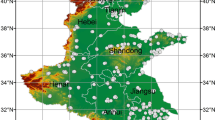Abstract
The PM2.5 (particulate matter with a diameter of fewer than 2.5 µm) has become a global topic in environmental science. The neural network that based on the non-linear regression algorithm, e.g., deep learning, is now believed to be one of the most facile and advanced approaches in PM2.5 concentration prediction. In this study, we proposed a PM2.5 predictor using deep learning as infrastructure and meteorological data as input, for predicting the next hour PM2.5 concentration in Beijing Aotizhongxin monitor point. We efficiently use the parameter’s spatiotemporal correlation by concatenating the dataset with time series. The predicted PM2.5 concentration was based on meteorology changes over a period. Therefore, the accuracy would increase with the period growing. By extracting the intrinsic features between meteorological and PM2.5 concentration, a fast and accurate prediction was carried out. The R square score reached maximum of 0.98 and remained an average of 0.9295 in the whole test. The average bias of the model is 9 μg on the validation set and 1 μg on the training set. Moreover, the differences between the predictions and expectations can be further regarded as the estimation for the emission change. Such results can provide scientific advice to supervisory and policy workers.











Similar content being viewed by others
Data availability
The datasets generated during and/or analyzed during the current study are available from the corresponding authors upon reasonable request.
References
Alduchov, O. A., & Eskridge, R. E. (1996). Improved Magnus form approximation of saturation vapor pressure. Journal of Applied Meteorology and Climatology, 35(4), 601–609. https://doi.org/10.1175/1520-0450(1996)035%3c0601:IMFAOS%3e2.0.CO;2
Bai, Y., Li, Y., Zeng, B., Li, C., & Zhang, J. (2019). Hourly PM2.5 concentration forecast using stacked autoencoder model with emphasis on seasonality. Journal of Cleaner Production, 224, 739–750. https://doi.org/10.1016/j.jclepro.2019.03.253
Buck, A. L. (1981). New equations for computing vapor pressure and enhancement factor. Journal of Applied Meteorology and Climatology, 20(12), 1527–1532. https://doi.org/10.1175/1520-0450(1981)020%3c1527:NEFCVP%3e2.0.CO;2
Chen, X., Yang, T., Wang, Z., Hao, Y., He, L., & Sun, H. (2020). Investigating the impacts of coal-fired power plants on ambient PM2.5 by a combination of a chemical transport model and receptor model. Science of The Total Environment, 727, 138407. https://doi.org/10.1016/j.scitotenv.2020.138407
Cort, J. W., & Kenji, M. (2005). Advantages of the mean absolute error (MAE) over the root mean square error (RMSE) in assessing average model performance. Climate Research, 30(1), 79–82. https://doi.org/10.3354/cr030079
Cui, H., Chen, W., Dai, W., Liu, H., Wang, X., & He, K. (2015). Source apportionment of PM2.5 in Guangzhou combining observation data analysis and chemical transport model simulation. Atmospheric Environment, 116, 262–271. https://doi.org/10.1016/j.atmosenv.2015.06.054
Dai, H., Huang, G., Zeng, H., & Yu, R. (2022). VAR-tree model based spatio-temporal characterization and prediction of O3 concentration in China. Systems, 10(6), 263. https://doi.org/10.3390/systems1006026
Dai, H., Huang, G., Wang, J., & Zeng, H. (2023). VAR-tree model based spatio-temporal characterization and prediction of O3 concentration in China. Ecotoxicology and Environmental Safety, 257, 114960. https://doi.org/10.1016/j.ecoenv.2023.114960
Heaton, J. (2018). Ian Goodfellow, Yoshua Bengio, and Aaron Courville: Deep learning. Genetic Programming and Evolvable Machines, 19(1), 305–307. https://doi.org/10.1007/s10710-017-9314-z
Hochreiter, S., & Schmidhuber, J. (1997). Long short-term memory. Neural Computation, 9(8), 1735–1780. https://doi.org/10.1162/neco.1997.9.8.1735
Huang, C.-J., & Kuo, P.-H. (2018). A deep CNN-LSTM model for particulate matter (PM2.5) forecasting in smart cities. Sensors, 18(7), 2220. https://doi.org/10.3390/s18072220
Huang, C., Hu, J., Xue, T., Xu, H., & Wang, M. (2021). High-resolution spatiotemporal modeling for ambient PM2.5 exposure assessment in China from 2013 to 2019. Environmental Science Technology, 55(3), 2152–2162. https://doi.org/10.1021/acs.est.0c05815
Kumar, V., & Sahu, M. (2021). Evaluation of nine machine learning regression algorithms for calibration of low-cost PM2.5 sensor. Journal of Aerosol Science, 157, 105809. https://doi.org/10.1016/j.jaerosci.2021.105809
Lee, A., Jeong, S., Joo, J., Park, C.-R., Kim, J., & Kim, S. (2021). Potential role of urban forest in removing PM2.5: A case study in Seoul by deep learning with satellite data. Urban Climate, 36, 100795. https://doi.org/10.1016/j.uclim.2021.100795
Lightstone, S. D., Moshary, F., & Gross, B. (2017). Comparing CMAQ forecasts with a neural network forecast model for PM2.5 in New York. Atmosphere, 8(9), 161. https://doi.org/10.3390/atmos8090161
Pak, U., Ma, J., Ryu, U., Ryom, K., Juhyok, U., Pak, K., & Pak, C. (2020). Deep learning-based PM2.5 prediction considering the spatiotemporal correlations: A case study of Beijing, China. Science of the Total Environment, 699, 133561. https://doi.org/10.1016/j.scitotenv.2019.07.367
Seidel, D. J., & Birnbaum, A. N. (2015). Effects of Independence Day fireworks on atmospheric concentrations of fine particulate matter in the United States. Atmospheric Environment, 115, 192–198. https://doi.org/10.1016/j.atmosenv.2015.05.065
Song, M., Jeong, R., Kim, D., Qiu, Y., Meng, X., Wu, Z., & Ahn, J. (2022). Comparison of phase states of PM2.5 over megacities, Seoul and Beijing, and their implications on particle size distribution. Environmental Science Technology, 56(24), 17581–17590. https://doi.org/10.1021/acs.est.2c06377
Suriya, Natsagdorj, N., Aorigele, Zhou, & H., Sachurila. (2023). Prediction of PM2.5 concentration in Ulaanbaatar with deep learning models. Urban Climate, 47, 101357. https://doi.org/10.1016/j.uclim.2022.101357
Tai, A. P. K., Mickley, L. J., & Jacob, D. J. (2010). Correlations between fine particulate matter (PM2.5) and meteorological variables in the United States: Implications for the sensitivity of PM2.5 to climate change. Atmospheric Environment, 44(32), 3976–3984. https://doi.org/10.1016/j.atmosenv.2010.06.060
Teng, M., Li, S., Xing, J., Fan, C., Yang, J., Wang, S., Song, G., Ding, Y., Dong, J., & Wang, S. (2023). 72-Hour real-time forecasting of ambient PM(2.5) by hybrid graph deep neural network with aggregated neighborhood spatiotemporal information. Environment International, 176, 107971. https://doi.org/10.1016/j.envint.2023.107971
Vlachogianni, A., Kassomenos, P., Karppinen, A., Karakitsios, S., & Kukkonen, J. (2011). Evaluation of a multiple regression model for the forecasting of the concentrations of NOx and PM10 in Athens and Helsinki. Science of the Total Environment, 409(8), 1559–1571. https://doi.org/10.1016/j.scitotenv.2010.12.040
Wang, J., & Ogawa, S. (2015). Effects of meteorological conditions on PM2.5 concentrations in Nagasaki, Japan. International Journal of Environmental Research and Public Health, 12(8), 9089–9101. https://doi.org/10.3390/ijerph120809089
World Health Organization (WHO). (2016). Ambient air pollution: A global assessment of exposure and burden of disease. World Health Organization.
Yan, L., Zhou, M., Wu, Y., & Yan, L. (2018). Long short term memory model for analysis and forecast of PM2.5. Paper presented at the Cloud Computing and Security, Cham.
Yang, F. (2016). Under the dome: “Chinese” smog as a viral media event. Critical Studies in Media Communication, 33(3), 232–244. https://doi.org/10.1080/15295036.2016.1170172
Yang, J., Song, D., Fang, D., & Wu, F. (2019). Drivers of consumption-based PM2.5 emission of Beijing: A structural decomposition analysis. Journal of Cleaner Production, 219, 734–742. https://doi.org/10.1016/j.jclepro.2019.02.109
Yang, J., Yan, R., Nong, M., Liao, J., Li, F., & Sun, W. (2021). PM2.5 concentrations forecasting in Beijing through deep learning with different inputs, model structures and forecast time. Atmospheric Pollution Research, 12(9), 101168. https://doi.org/10.1016/j.apr.2021.101168
Yoo, W., Mayberry, R., Bae, S., Singh, K., Peter He, Q., & Lillard, J. W., Jr. (2014). A study of effects of multicollinearity in the multivariable analysis. International Journal of Applied Science and Technology, 4(5), 9–19.
Yue, T., Zhang, X., Wang, C., Zuo, P., Tong, Y., Gao, J., & Gao, X. (2018). Environmental impacts of the revised emission standard for air pollutants for boilers during the heating season in Beijing, China. Aerosol and Air Quality Research, 18(11), 2853–2864. https://doi.org/10.4209/aaqr.2018.02.0046
Zhang, Z., Zang, Z., Cheng, X., Lu, C., Huang, S., Hu, Y., & Ye, L. (2021). Development of three-dimensional variational data assimilation method of aerosol for the CMAQ model: An application for PM2.5 and PM10 forecasts in the Sichuan Basin. Earth and Space Science, 8(5), e2020EA001614. https://doi.org/10.1029/2020EA001614
Zhou, Q., Jiang, H., Wang, J., & Zhou, J. (2014). A hybrid model for PM2.5 forecasting based on ensemble empirical mode decomposition and a general regression neural network. Science of the Total Environment, 496, 264–274. https://doi.org/10.1016/j.scitotenv.2014.07.051
Zhu, M., & Xie, J. (2023). Investigation of nearby monitoring station for hourly PM2.5 forecasting using parallel multiinput 1D-CNN-biLSTM. Expert Systems with Applications, 211, 118707. https://doi.org/10.1016/j.eswa.2022.118707
Acknowledgements
The scientific calculations in this paper have been done on the HPC Cloud Platform of Shandong University. The views and ideas expressed herein are solely those of the authors and do not represent the opinions of the funding agencies in any form. The views and ideas expressed herein are solely those of the authors.
Author information
Authors and Affiliations
Contributions
All authors contributed to the study’s conception and design. YL and JM contributed equally to this work. Material preparation, data collection, and analysis were performed by YL, JM, CT, and NK. YL and JM wrote the first draft of the manuscript, and all authors commented on previous versions. DW: writing—review and editing, supervision. All authors read and approved the final manuscript.
Corresponding author
Ethics declarations
Ethics approval and consent to participate
All authors have read, understood, and have complied as applicable with the statement on “Ethical responsibilities of Authors” as found in the Instructions for Authors and are aware that with minor exceptions, no changes can be made to authorship once the paper is submitted.
Competing interests
The authors declare that they have no known competing financial interests or personal relationships that could have appeared to influence the work reported in this paper.
Additional information
Publisher's Note
Springer Nature remains neutral with regard to jurisdictional claims in published maps and institutional affiliations.
Rights and permissions
Springer Nature or its licensor (e.g. a society or other partner) holds exclusive rights to this article under a publishing agreement with the author(s) or other rightsholder(s); author self-archiving of the accepted manuscript version of this article is solely governed by the terms of such publishing agreement and applicable law.
About this article
Cite this article
Liang, Y., Ma, J., Tang, C. et al. Hourly forecasting on PM2.5 concentrations using a deep neural network with meteorology inputs. Environ Monit Assess 195, 1510 (2023). https://doi.org/10.1007/s10661-023-12081-0
Received:
Accepted:
Published:
DOI: https://doi.org/10.1007/s10661-023-12081-0




